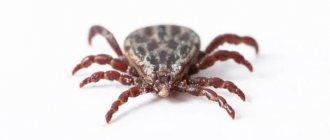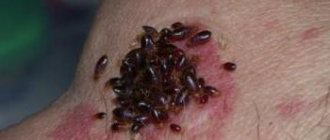Many people think that ticks can only bite a person or a dog, without posing a danger to the cat family. This is not true; according to statistics, cats suffer from tick bites and develop complications much less frequently, but the course of the disease, diagnosis and treatment are more difficult. Even domestic cats require special attention, since the parasite can enter the house through shoes or on human clothing.
Ticks are especially active from March to November; they can be found in grass or bushes, in city parks, and forests. Parasites pose a danger to walking animals, but even if the animal does not leave the house or apartment, the risk of finding a parasite in a cat is not so small.
What to do if your cat is bitten by a tick
If a cat is bitten by a tick, it is necessary to determine its type, of which there are more than 1000: dust ticks, ear ticks, scabies, etc. Ixodid ticks are considered the most dangerous for cats, as they are carriers of pathogens of many diseases.
It is necessary to examine the surface of the skin to determine the extent of its penetration. It is advisable if a specialist removes the parasite, since there is a risk of leaving part of the head under the skin. Also, when the insect moves strongly, the spread of infection increases.
Most often, bloodsuckers choose to bite the groin area, behind the hind legs, ears, stomach and armpit. An attached parasite is visible to the naked eye; immediately after detection, it is advisable to isolate the cat from children, take it to the veterinarian, or try to get rid of the insect yourself.
If a cat is bitten by a tick, then at this moment the animal does not experience pain or discomfort because upon penetration the parasite releases pain-relieving enzymes. Therefore, during the active months of parasite reproduction, you should regularly examine your cat; you can run a comb against the grain and feel the vulnerable spots.
How to keep your pet safe?
Check the coat after every walk. The simplest thing is to prevent the bite itself, because the tick crawls on the victim for quite a long time before biting. Along with the inspection, it is also better to comb the fur with a fine-toothed comb so that the tick remains on it if it is still crawling.
And don’t forget that you can only walk outside with protection: a collar, drops or spray against ticks and fleas. If your cat brings ticks home despite the presence of protection, change the product to a more effective one.
Rate and share!
Symptoms of a bite in cats
Symptoms of a tick bite in cats do not appear immediately after detection; the animal behaves calmly, has good appetite and sleep, and the cat does not feel pain, since the parasite uses pain-relieving enzymes during its introduction.
After it has been removed from the skin, it is necessary to monitor the condition of the pet. In case of infection and infection enters the bloodstream, the disease can begin to manifest itself only after a few weeks - the incubation period of infectious diseases.
Symptoms of a tick bite in a cat that should alert you:
- urine has turned pink;
- cough, heavy breathing;
- paleness of the nasal mucous membranes;
- vomiting, bowel dysfunction;
- signs of dehydration;
- sudden weight loss;
- loss of appetite or complete refusal;
- lethargy, lack of interest in the environment;
- heat.
If one or more symptoms occur, you should contact your veterinarian to preserve the health and life of your pet.
Symptoms of encephalitis
Encephalitis in cats is a serious pathology and the sooner the animal’s owner detects its signs, the more chances he will have to save the animal.
Encephalitis in cats is presented by a number of signs that depend on the severity of the disease. In the first few weeks after infection, your pet will develop:
- fever accompanied by an increase in temperature;
- apathy, drowsiness and lethargy;
- various changes in behavior that are not typical for a pet;
- lacrimation and mucus discharge from the nose;
- diarrhea and vomiting;
- refusal to eat.
If the symptoms are ignored, the disease will progress to the next stage, which is characterized by:
- paralysis and weakening of limbs;
- blindness and deafness;
- convulsive syndrome;
- tremor of the limbs and lower jaw;
- impaired coordination of movements;
- tension in the neck muscles with the inability to tilt the head forward;
- headache;
- dehydration and sudden weight loss.
"Note! If the pathology is caused by a tick bite, then it can proceed much faster, and the first symptoms may appear after a few hours.”
Consequences of a bite
Are ticks dangerous for cats? The parasite's bite itself does not threaten the health of the pet; the danger lies in the pathogens that can get from it to the animal through the bite. The Ixodid tick can cause the development of diseases such as piroplasmosis, hemorrhagic fever, typhus and encephalitis, and borreliosis.
If treatment is not started on time, the infection can affect many body systems and internal organs of your furry friend.
If a cat is bitten by a tick, the consequences, symptoms and treatment depend on the type of infection. Some diseases only affect the cat’s immune system, it becomes lethargic and apathetic, but treatment in this case is 95% effective. Other diseases may not respond to treatment and lead to the death of the pet.
Stages of the disease
Encephalitis in cats has several stages of development:
- Incubation period. If the cat has a strong immune system, then this stage can develop up to two weeks. During this time, the animal will experience cold-like symptoms, including high fever and discharge from the eyes and nose.
- Neurology. During this period, damage occurs to the nervous system, or more precisely, to the neurons of the brain. The severity of the disease will influence the symptoms.
- Intoxication. In addition to damaging nerve cells, at this stage pathogenic microorganisms begin to release toxic substances leading to intoxication.
To save his cat, the owner needs to help her until she develops a severe form of intoxication and the disease affects all systems and organs.
What to do at home if you are bitten
If the bloodsucker has not burrowed into the pet’s skin and it is found on the fur or in the place where the cat sleeps, then it is necessary to inspect the skin. Using a comb, you need to comb the animal against the fur, push it apart with your hands and inspect the skin. Favorite places for parasites to invade are the armpits, hind legs, stomach and groin. If a bite is detected, it is necessary to treat the wound or take it to a veterinary hospital; you should monitor the cat’s health for several weeks; if deterioration occurs, you should consult a doctor.
You can get rid of the parasite as follows:
- Wear gloves on your hands, and upon completion of all manipulations, carefully perform hygiene.
- To prevent the infection from spreading faster, do not lubricate the area around the tick with oil.
- You should not pull the parasite, this will lead to further penetration of the insect's head and the spread of infection.
- The tick must be removed completely without damaging it.
- You can remove the insect using thread or tweezers. You should grab the body of the parasite and pull it out gently and without sudden movements.
- If, however, part of the tick’s head remains in the skin, there is no need to worry too much, since the cat’s body can independently reject the remaining body. This often leads to the development of a small abscess, which can be prevented by contacting a veterinarian.
Treatment is prescribed only by a veterinarian based on the test results and existing symptoms; usually, antibiotic therapy cannot be avoided. You are allowed to treat the bite site yourself at home using antiseptic drugs, with the exception of iodine and brilliant green.
Diagnosis of encephalitis
To make a diagnosis, the veterinarian needs to collect a complete history, examine the pet and take a blood and cerebrospinal fluid test. If pus is found in the cerebrospinal fluid, the doctor may suspect meningitis, and a large number of red blood cells and proteins indicates inflammation of the brain, more typical of encephalitis.
If the veterinarian suspects that encephalitis is caused by a virus, a serology blood test is performed. In case of inflammation of the meninges caused by otitis, an examination of the animal's inner ear is carried out.
When a tick is found on a cat’s body, the veterinarian removes it and performs an analysis to determine the causative agent of the disease. If the animal has been around for more than one day, then tick-borne encephalitis in a cat begins to show typical symptoms, from which one can understand that it was the insect that caused the development of the disease.
Ixodid ticks in cats
A tick bite that carries piroplasmosis or encephalitis does not pose a danger to a cat, but other more dangerous diseases can develop, such as theileriosis, tularemia and hemobartonellosis. Ixodid ticks are one of the most famous types of parasites, common in many climatic zones.
Symptoms and consequences have different characteristics - it all depends on the type of pathogen. Each disease has a distinctive clinical picture and incubation period:
- Hemobartonellosis. This infectious disease causes anemia only in cats; the disease is not dangerous for humans and dogs. The infection, spreading throughout the body, settles in the lymph nodes, bone marrow, liver and spleen. The incubation period ranges from several days to three weeks. The manifestation of symptoms depends on the animal’s immune defense; with weak immunity, the disease becomes severe. The disease manifests itself in decreased appetite, rapid heartbeat, lethargy and fading of the cat, the skin is pale or yellow, and the temperature is elevated. Only an urgent visit to the veterinarian can save the life of a pet.
- Tularemia. The pathogen enters the lymph nodes through the cat’s blood, developing a purulent inflammatory process. After some time, the lesions are opened, which leads to even greater blood infection. The disease affects the spleen, liver and lungs. Tularemia manifests itself in the form of lethargy of the animal, the skin becomes yellowish, small ulcerations form on the mucous surfaces, the lymph nodes in the neck are enlarged, the animal experiences malaise and fever. If treatment is not started in time, the cat dies in a matter of time, one of the causes of death is necrosis of the tissues of the spleen, lungs and liver. This disease is dangerous to humans and is transmitted through contact.
- Theileriosis. The infection, entering the animal's blood, multiplies in the spleen, lungs, liver and lymph nodes, causing severe damage. The first symptoms appear 1–3 weeks after the tick bite: the cat becomes lethargic, the temperature rises, the skin is yellow, the cat looks thin and apathetic, and the appetite disappears. Upon examination, the veterinarian notes an increase in internal organs. The disease is difficult for cats to tolerate, and only timely treatment can save the animal’s life.
To prevent such consequences after an ixodid tick bite, it is necessary to carry out prevention, constant examination of the animal and timely treatment.
Therapy
If symptoms of encephalitis occur in a cat, it should be taken to a veterinary clinic and left under the supervision of specialists who will be able to carry out all the necessary measures and monitor its condition.
To relieve cerebral edema and prevent its development, the animal is injected with diuretics such as Veroshpiron or Furosemide, as well as potassium supplements.
In order to relieve intoxication, the cat is given intravenous infusions of Ringer's solution and glucose.
In addition, the pet is given antibiotics that can fight not only the infection itself, but also overcome the blood-brain barrier. These may be drugs of the ampicillin or cyclosporine series.
If a cat has seizures, she is prescribed Diazepam or Phenobarbital, and to improve brain activity, nootropics such as Phenibut and Cerrebrolysin. If respiratory function is impaired, she is connected to a ventilator.
If the animal can be saved, it will undergo long-term rehabilitation therapy, including electrophoresis, massage and manual therapy.
Can a tick fall off on its own from a cat?
Ticks and cats are a hot topic for the hot season, since it is in the summer that animals most often suffer from parasite bites. Having discovered a parasite attached to a pet, many people have a question: can the tick fall off on its own?
It is better not to wait until it detaches itself; it is necessary to remove the insect as soon as possible, since the longer the parasite is under the skin, the more infection will enter the blood. In some cases, when the tick is completely saturated with blood, it is able to fall off on its own.
Kinds
Most often, the animal is affected by a microorganism called demodex. It cannot be seen without a microscope. It is shaped like a worm.
Demodicosis occurs in two varieties:
- localized;
- generalized.
With a localized form, a certain part of the skin is affected. In the case of a generalized form, the entire body is affected.
In this situation, after treatment, the cat should undergo a sterilization procedure, since the microorganism can be transmitted to offspring.
Can a cat die from a tick bite?
Are ticks dangerous for cats? The parasite itself does not pose a danger to the animal if it is not the causative agent of any disease.
Can a cat die from a tick bite? With timely treatment and treatment, the animal’s health is restored without complications. If urgent measures are not taken, the animal’s body weakens in a matter of time, exhaustion and disruption of the functioning of internal organs are observed, which leads to serious consequences, including death.
Preventive actions
To minimize the likelihood of disease, the cat owner must:
- inspect your pet after walks for ticks;
- vaccinate against viral infections;
- vaccinate against rabies;
- limit your tailed pet’s communication with homeless and wild animals;
- promptly treat diseases of the ENT organs;
- Isolate the cat if it is bitten by a wild animal in order to monitor the possible development of rabies.
- Carry out deworming every six months.
By following these recommendations, infection with encephalitis can be minimized.
Are ticks on a cat dangerous for humans?
If it has already been saturated with cat blood, then it poses no danger to the human body. It is worth remembering that the parasite cannot infect a cat with encephalitis, while this disease is very dangerous for humans.
Having discovered a tick on an animal, it is possible that there may be several such parasites on the pet, in which case there is a risk that the insect will move onto a person’s skin and bite him. Therefore, it is important to examine your pet for parasites while wearing protective gloves.
Prevention
Preventing ticks from infesting cats by preventing contact with their relatives is almost impossible. The only way out is to prevent tick attacks on cats by using flea collars, drops and water-soluble emulsions.
If there are unfavorable areas for ticks in your area, they should be avoided. Before letting your cat into your apartment, you need to thoroughly comb out the fur with a fine comb and inspect the belly, paws, chest and ears for ticks.
Given that mites have the ability to survive for some time outside the cat's body, owners must protect their animals from re-infestation.
It is better to burn low-value items in the apartment, treat the floors with an acaricidal spray and wash them thoroughly.
Regular deworming, vaccination, disinfestation, and adequate feeding will provide the cat with strong immunity, which will not allow ticks that have fallen on the cat to actively reproduce.











